Match Analysis in Women’s Tennis on Clay, Grass and Hard Courts
Abstract
:1. Introduction
2. Materials and Methods
2.1. Design
2.2. Sample
2.3. Instruments
2.4. Procedure
2.5. Data Analysis
3. Results
3.1. Traditional Statistical Analysis
3.2. Sequential Analysis
3.2.1. Sequential Analysis of FIRST Service
3.2.2. Sequential Analysis of Second Service
4. Discussion
4.1. Performance Indicators
4.2. Play Sequences
4.3. Practical Recommendations
4.4. Limitations
5. Conclusions
Supplementary Materials
Author Contributions
Funding
Institutional Review Board Statement
Informed Consent Statement
Data Availability Statement
Conflicts of Interest
References
- Alonso-Dos-Santos, M.; Vveinhardt, J.; Calabuig-Moreno, F.; Montoro-Rios, F.J. Involvement and image transfer in sports sponsorship. Eng. Econ. 2016, 27, 78–89. [Google Scholar] [CrossRef] [Green Version]
- Kovacs, M.S. Tennis Physiology. Sports Med. 2007, 37, 189–198. [Google Scholar] [CrossRef] [PubMed]
- Fitzpatrick, A.; Stone, J.A.; Choppin, S.; Kelley, J. Investigating the most important aspect of elite grass court tennis: Short points. Int. J. Sports Sci. Coach. 2021, 16, 1178–1186. [Google Scholar] [CrossRef]
- Delgado-García, G.; Vanrenterghem, J.; Muñoz-García, A.; Ruiz-Malagón, E.J.; Mañas-Bastidas, A.; Soto-Hermoso, V.M. Probabilistic structure of errors in forehand and backhand groundstrokes of advanced tennis players. Int. J. Perform. Anal. Sport 2019, 19, 698–710. [Google Scholar] [CrossRef]
- Fernández-García, Á.; Blanca-Torres, J.C.; Nikolaidis, P.T.; Torres-Luque, G. Differences in competition statistics between winners and losers in male and female tennis players in Olympic Games. Ger. J. Exerc. Sport Res. 2019, 49, 313–318. [Google Scholar] [CrossRef]
- Fitzpatrick, A.; Stone, J.A.; Choppin, S.; Kelley, J. Important performance characteristics in elite clay and grass court tennis match-play. Int. J. Perform. Anal. Sport 2019, 19, 942–952. [Google Scholar] [CrossRef]
- Martin, C.; Prioux, J. Tennis Playing Surfaces: Effects on Performance. J. Med. Sci. Tennis 2016, 21, 11–19. [Google Scholar]
- Mecheri, S.; Rioult, F.; Mantel, B.; Kauffmann, F.; Benguigui, N. The serve impact in tennis: First large-scale study of big Hawk-Eye data. Stat. Anal. Data Min. 2016, 9, 310–325. [Google Scholar] [CrossRef]
- O’Donoghue, P.G.; Brown, E.J. The importance of service in Grand Slam singles tennis. J. Perform. Anal. Sport 2008, 8, 70–78. [Google Scholar] [CrossRef]
- Prieto-Lage, I.; Prieto, M.A.; Curran, T.P.; Gutiérrez-Santiago, A. An Accurate and Rapid System to Identify Play Patterns in Tennis Using Video Recording Material: Break Point Situations as a Case Study. J. Hum. Kinet. 2018, 62, 199–212. [Google Scholar] [CrossRef] [Green Version]
- Johnson, C.D.; McHugh, M.P. Performance demands of professional male tennis players. Br. J. Sports Med. 2006, 40, 696–699. [Google Scholar] [CrossRef] [PubMed] [Green Version]
- Reid, M.; Morgan, S.; Whiteside, D. Matchplay characteristics of Grand Slam tennis: Implications for training and conditioning. J. Sports Sci. 2016, 34, 1791–1798. [Google Scholar] [CrossRef] [PubMed]
- Kovalchik, S.A.; Reid, M. Comparing matchplay characteristics and physical demands of junior and professional tennis athletes in the era of big data. J. Sports Sci. Med. 2017, 16, 489–497. [Google Scholar] [PubMed]
- Torres-Luque, G.; Blanca-Torres, J.C.; Cabello-Manrique, D.; Fernández-García, A.I. Serve profile of male and female professional tennis players at the 2015 Roland Garros Grand Slam tournament. Ger. J. Exerc. Sport Res. 2019, 49, 319–324. [Google Scholar] [CrossRef]
- Filipčič, T.; Filipčič, A.; Berendijaš, T. Comparison of game characteristics of male and female tennis players at Roland Garros 2005. Acta Gymnica 2008, 38, 21–28. [Google Scholar]
- Cui, Y.; Gómez, M.Á.; Gonçalves, B.; Sampaio, J. Performance profiles of professional female tennis players in grand slams. PLoS ONE 2018, 13, e0200591. [Google Scholar] [CrossRef]
- O’Donoghue, P.; Ingram, B. A notational analysis of elite tennis strategy. J. Sports Sci. 2001, 19, 107–115. [Google Scholar] [CrossRef]
- Hizan, H.; Whipp, P.; Reid, M. Comparison of serve and serve return statistics of high performance male and female tennis players from different age-groups. Int. J. Perform. Anal. Sport 2011, 11, 365–375. [Google Scholar] [CrossRef]
- Anguera, M.T.; Blanco-Villaseñor, A.; Losada, J.L.; Portell, M. Guidelines for designing and conducting a study that applies observational methodology. Anu. Psicol. 2018, 48, 9–17. [Google Scholar] [CrossRef]
- Anguera, M.T.; Blanco-Villaseñor, A.; Hernández-Mendo, A.; Losada-López, J.L. Observational designs: Their suitability and application in sports psychology. Cuad. De Psicol. Del Deporte 2011, 11, 63–76. [Google Scholar]
- Gabin, B.; Camerino, O.; Anguera, M.T.; Castañer, M. Lince: Multiplatform Sport Analysis Software. Procedia—Soc. Behav. Sci. 2012, 46, 4692–4694. [Google Scholar] [CrossRef]
- Blanco-Villaseñor, A.; Anguera, M.T. Evaluación de la calidad en el registro del comportamiento: Aplicación a deportes de equipo. In Métodos Numéricos en Ciencias Sociales; Oñate, E., García-Sicilia, F., Ramallo, L., Eds.; Centro Internacional de Métodos Numéricos en Ingeniería: Barcelona, Spain, 2000; pp. 30–48. [Google Scholar]
- Cohen, J. Weighted kappa: Nominal scale agreement with provision for scaled disagreement of partial credit. Psychol. Bull. 1968, 70, 213–220. [Google Scholar] [CrossRef] [PubMed]
- Cui, Y.; Liu, H.; Liu, H.; Gómez, M.Á. Data-driven analysis of point-by-point performance for male tennis player in Grand Slams. Motricidade 2019, 15, 49–61. [Google Scholar] [CrossRef]
- Fernández-García, Á.; Blanca-Torres, J.C.; Hernández-García, R.; Torres-Luque, G. Analysis of the statistical variables related to the service in high performance male tennis in junior and absolute category. Cult. Cienc. Deporte 2019, 14, 289–295. [Google Scholar]
- Martínez-Gallego, R.; Guzmán, J.F.; James, N.; Ramón-Llin, J.; Crespo, M.; Vuckovic, G. The relationship between the incidence of winners/errors and the time spent in different areas of the court in elite tennis. J. Hum. Sport Exerc. 2013, 8, 2–5. [Google Scholar] [CrossRef] [Green Version]
- Brody, H. Bounce of a tennis ball. J. Sci. Med. Sport 2003, 6, 113–119. [Google Scholar] [CrossRef]
- Martin, C.; Prioux, J. The Effect of Playing Surfaces on Performance in Tennis. In Routledge Handbook of Ergonomics in Sport and Exercise; Routledge: London, UK, 2013; pp. 290–302. [Google Scholar] [CrossRef]
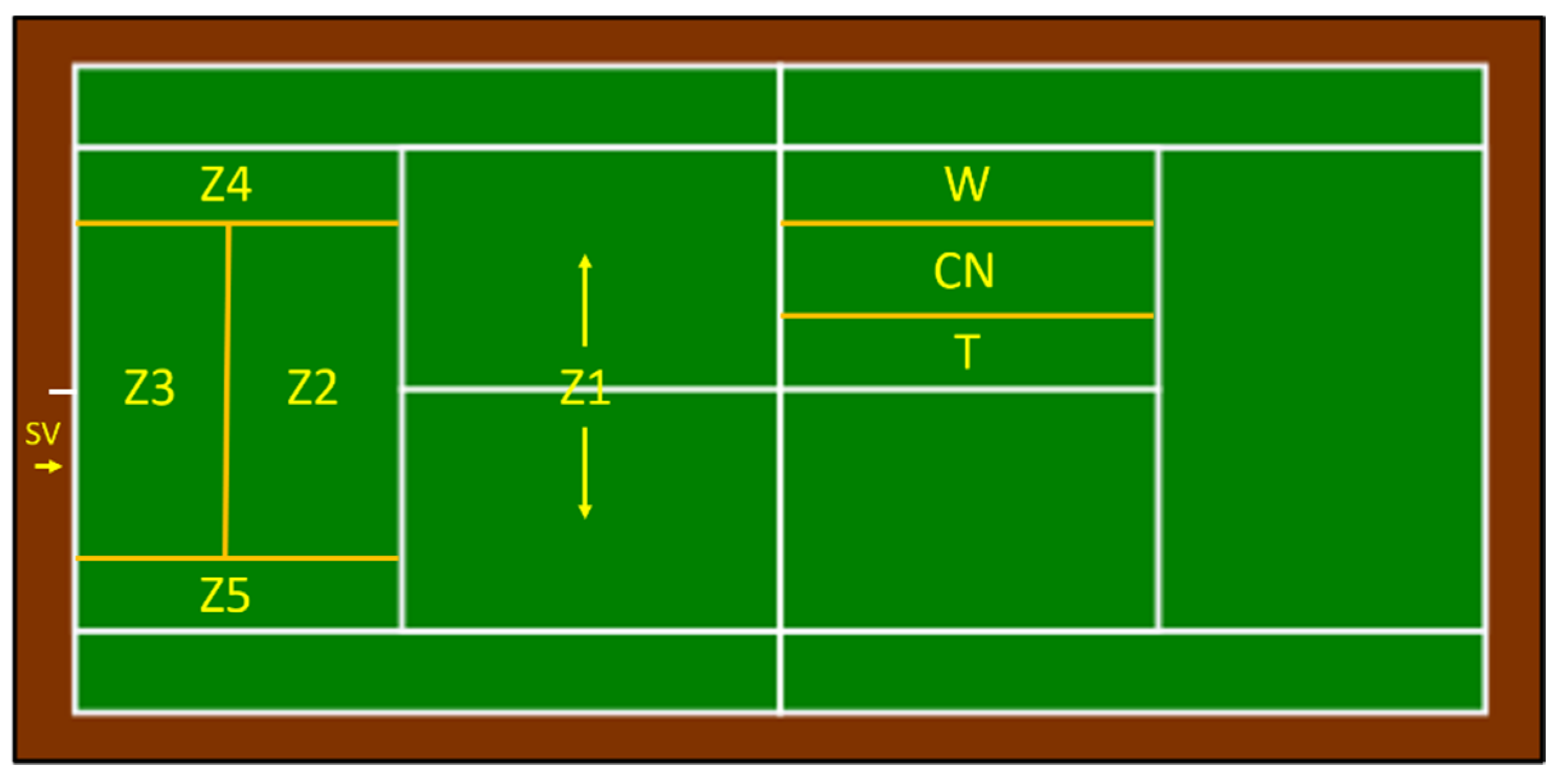
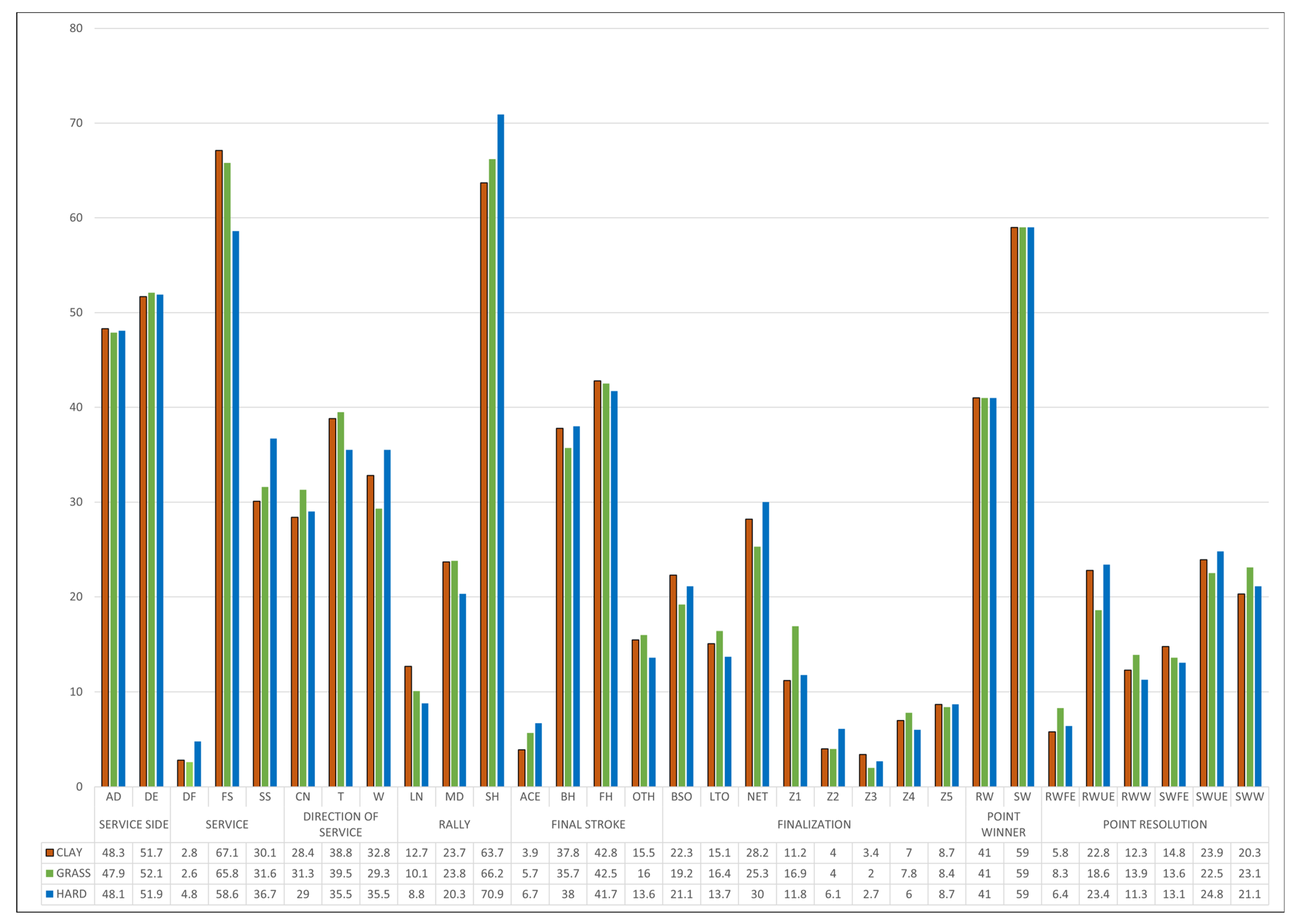
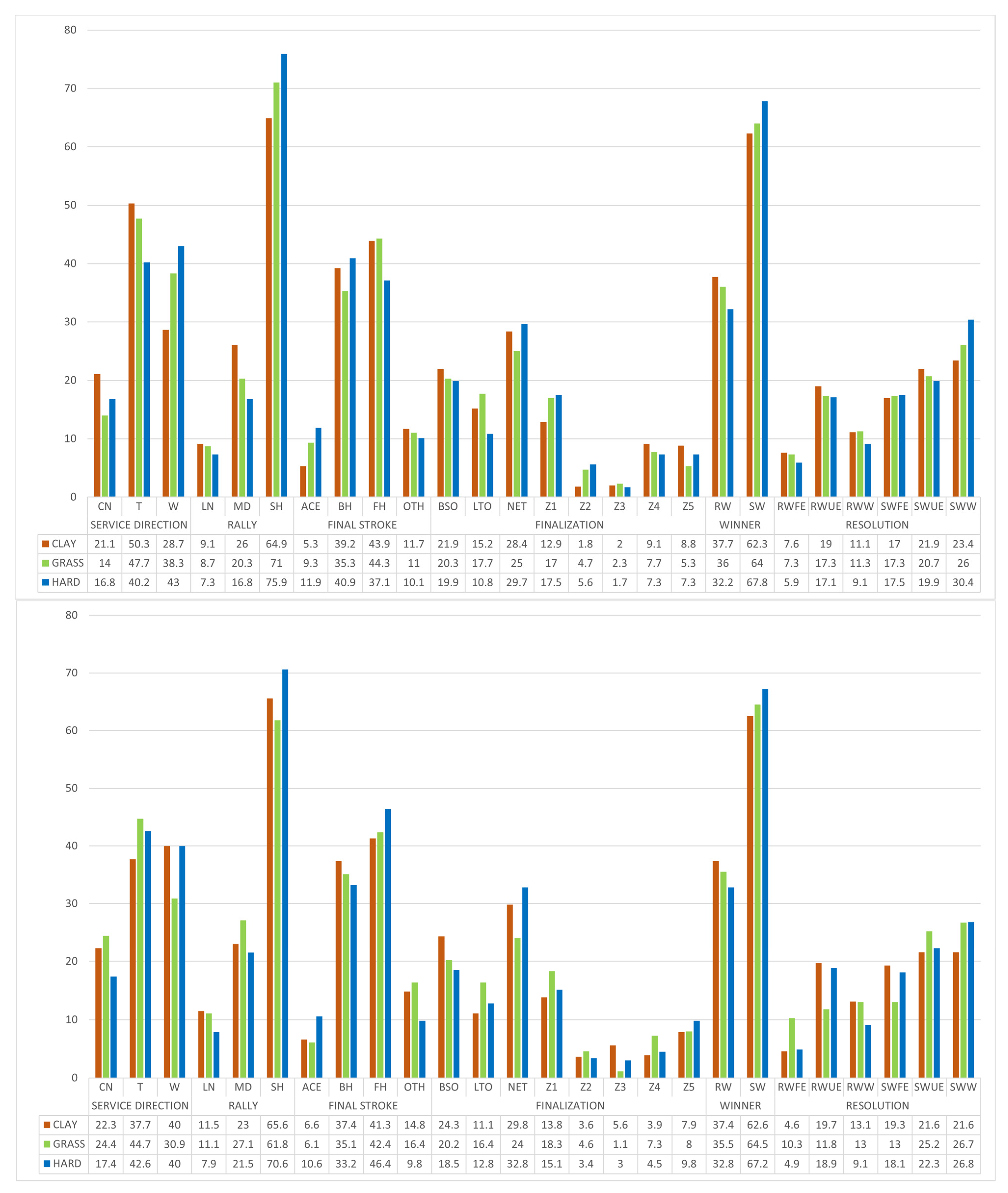
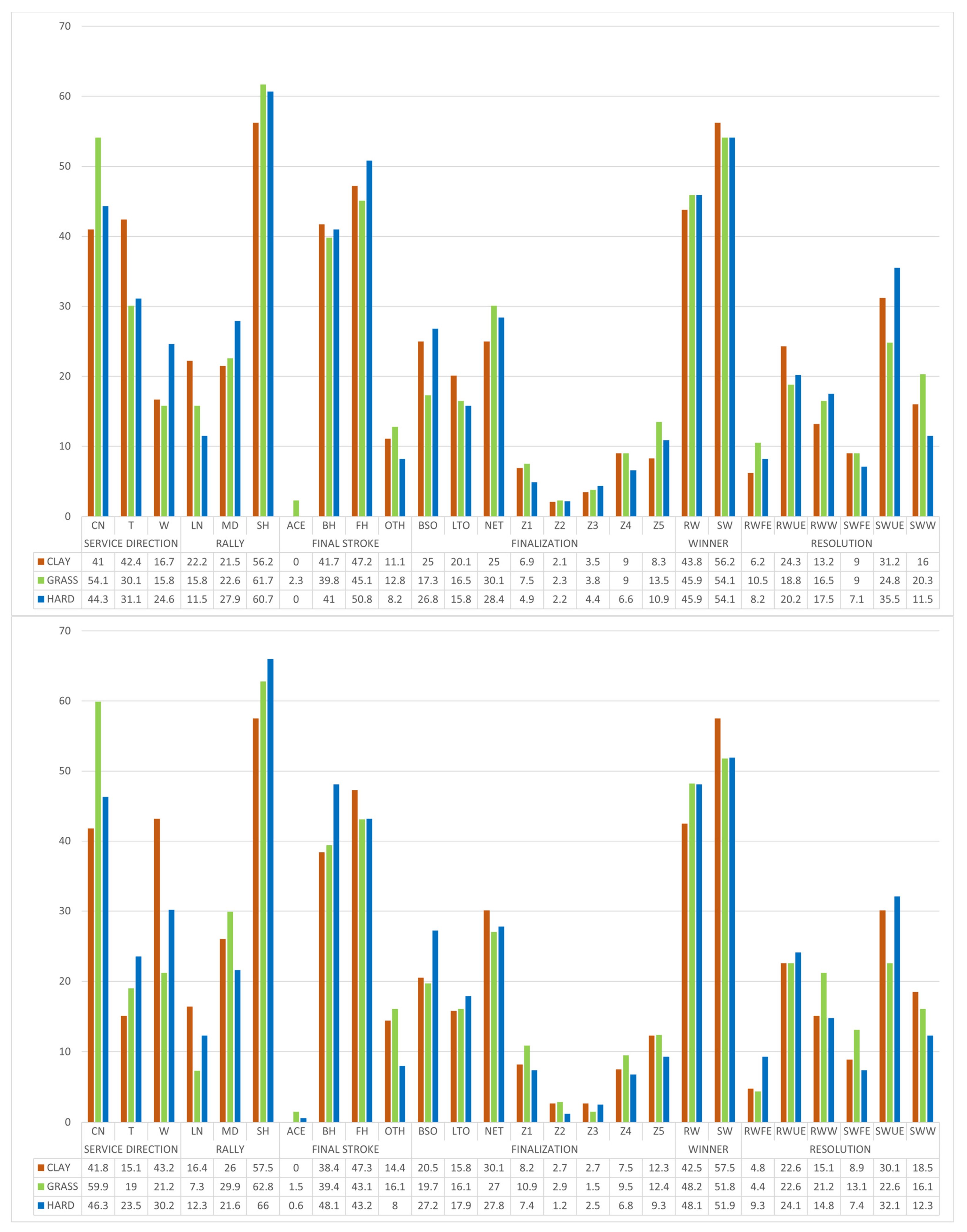
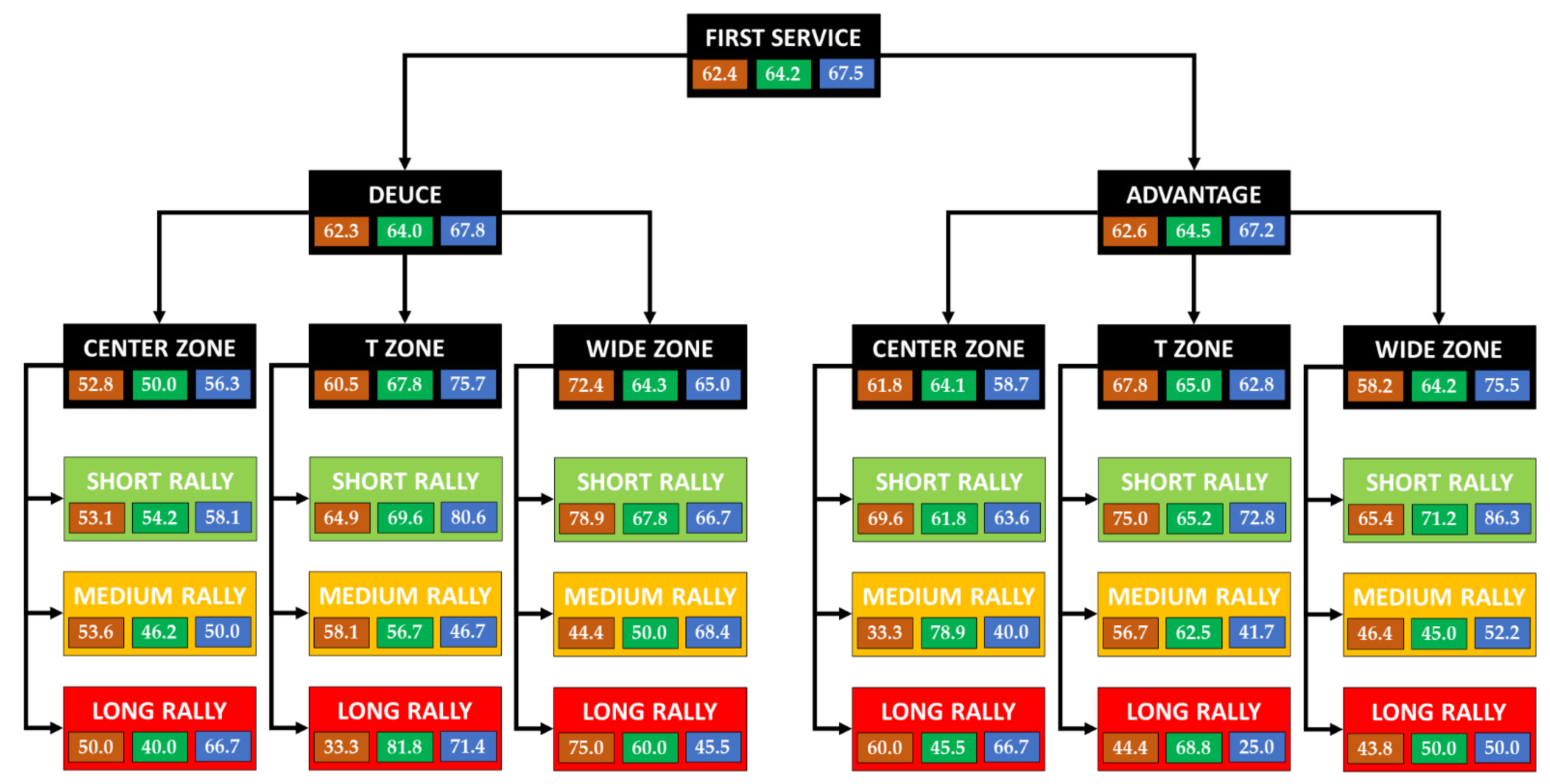
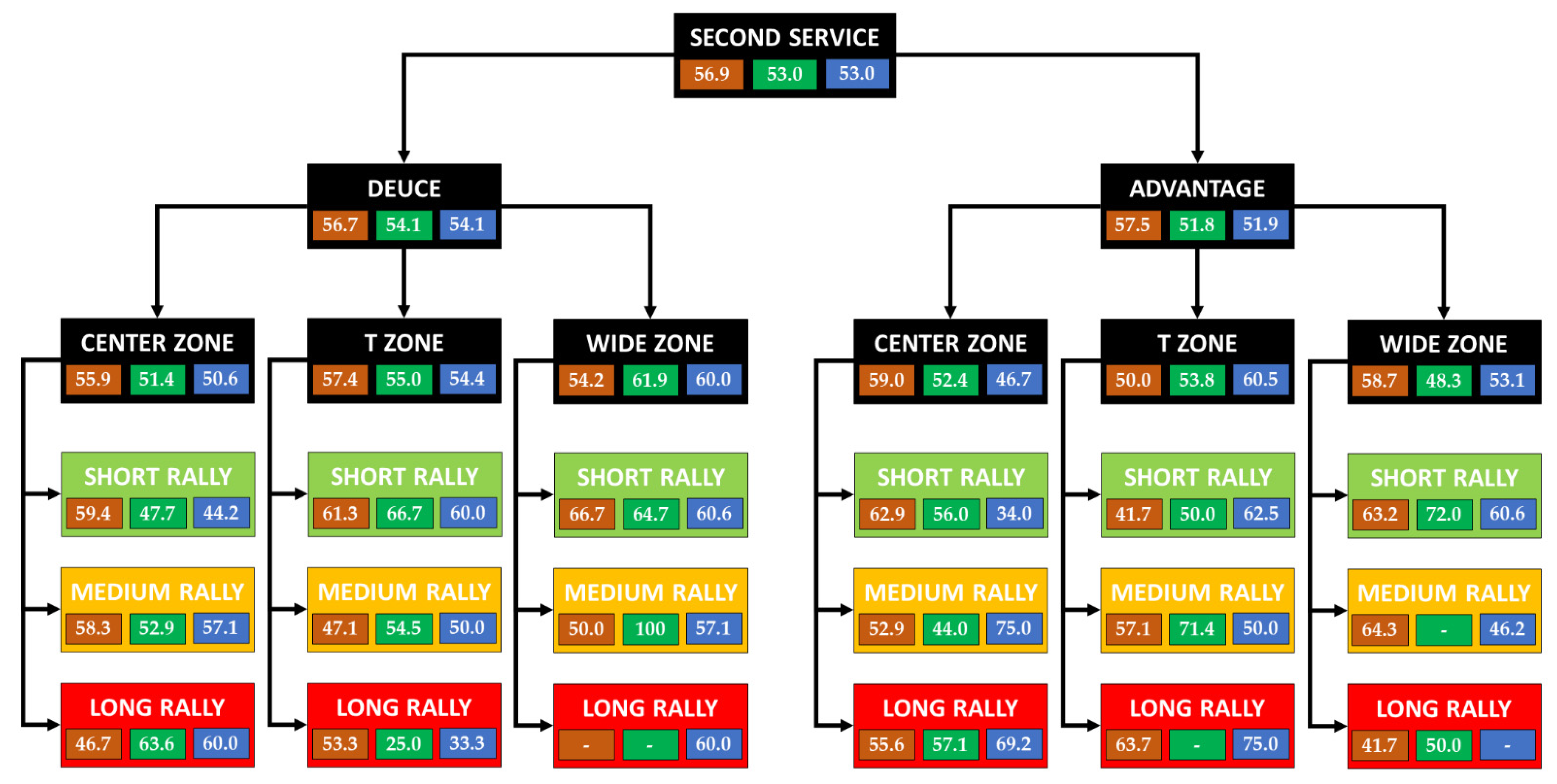
| Criteria | Code | Description |
|---|---|---|
| SURFACE | CL | Clay (Roland Garros’ match). |
| GR | Grass (Wimbledon’ match). | |
| HC | Hard court (US Open match). | |
| SERVICE SIDE | AD | The service is done to the advantage side. |
| DE | The service is done to the deuce side. | |
| SERVICE | DF | Double fault. |
| FS | Point is played with first service. | |
| SS | Point is played with second service. | |
| SERVICE DIRECTION | CN | Service to the center of the service quadrant. |
| T | Service to the T zone. | |
| W | Service to the wide zone. | |
| RALLY LENGTH | LN | Long rally (9+ shots). Does not count the service. |
| MD | Medium rally (5–8 shots). Does not count the service. | |
| SH | Short rally (0–4 shots). Does not count the service. | |
| FINAL STROKE | ACE | Direct service. |
| BH | Backhand stroke. | |
| FH | Forehand stroke. | |
| OTH | Other type of stroke (drop shot, smash, volley…). | |
| POINT FINALIZATION | Z1-Z5 | Court zone where ball finally lands (only for winning strokes). |
| NET | Final stroke goes to the net. | |
| LTO | Final stroke goes out of bounds on the side. | |
| BSO | Final stroke goes out of bounds at the base line. | |
| WINNER OF THE POINT | RW | The player that receives wins the point. |
| SW | The player that serves wins the point. | |
| POINT RESOLUTION | RWFE | The receiver wins with a forced error from the opponent. |
| RWUE | The receiver wins without a forced error from the opponent. | |
| RWW | The receiver wins with a winning stroke. | |
| SWFE | The player that serves wins with a forced error from the opponent. | |
| SWUE | The player that serves wins without a forced error from the opponent. | |
| SWW | The player that serves wins with a winning stroke. |
Publisher’s Note: MDPI stays neutral with regard to jurisdictional claims in published maps and institutional affiliations. |
© 2022 by the authors. Licensee MDPI, Basel, Switzerland. This article is an open access article distributed under the terms and conditions of the Creative Commons Attribution (CC BY) license (https://creativecommons.org/licenses/by/4.0/).
Share and Cite
Prieto-Lage, I.; Paramés-González, A.; Argibay-González, J.C.; Reguera-López-de-la-Osa, X.; Ordóñez-Álvarez, S.; Gutiérrez-Santiago, A. Match Analysis in Women’s Tennis on Clay, Grass and Hard Courts. Int. J. Environ. Res. Public Health 2022, 19, 7955. https://doi.org/10.3390/ijerph19137955
Prieto-Lage I, Paramés-González A, Argibay-González JC, Reguera-López-de-la-Osa X, Ordóñez-Álvarez S, Gutiérrez-Santiago A. Match Analysis in Women’s Tennis on Clay, Grass and Hard Courts. International Journal of Environmental Research and Public Health. 2022; 19(13):7955. https://doi.org/10.3390/ijerph19137955
Chicago/Turabian StylePrieto-Lage, Iván, Adrián Paramés-González, Juan Carlos Argibay-González, Xoana Reguera-López-de-la-Osa, Santiago Ordóñez-Álvarez, and Alfonso Gutiérrez-Santiago. 2022. "Match Analysis in Women’s Tennis on Clay, Grass and Hard Courts" International Journal of Environmental Research and Public Health 19, no. 13: 7955. https://doi.org/10.3390/ijerph19137955
APA StylePrieto-Lage, I., Paramés-González, A., Argibay-González, J. C., Reguera-López-de-la-Osa, X., Ordóñez-Álvarez, S., & Gutiérrez-Santiago, A. (2022). Match Analysis in Women’s Tennis on Clay, Grass and Hard Courts. International Journal of Environmental Research and Public Health, 19(13), 7955. https://doi.org/10.3390/ijerph19137955








